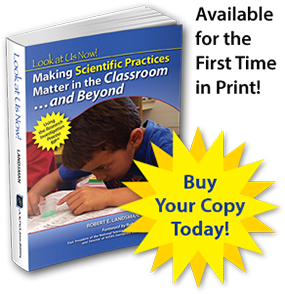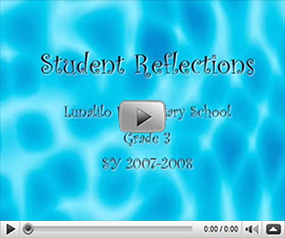The RIP® Q & A
We have compiled and answered some of the most commonly asked questions about Look at Us Now! Making Scientific Practices Matter in the Classroom...and Beyond and the Research Investigation Process (RIP®). If you have any questions that have not been addressed here, please contact us.
5. How does the Research Investigation Process (RIP®) address STEM?
The Research Investigation Process (RIP®) naturally unites the four content areas of STEM (science, technology, engineering, and mathematics) within each investigation. The RIP® can be used to facilitate the learning of new information in one or more of the four STEM content areas. In addition, every RIP®-based research investigation will involve student use of some or all of the scientific and engineering practices described in the Next Generation Science Standards (NGSS), application of mathematics for the analysis of data, and the use of technology for a variety of purposes.
To elaborate on this, the investigation will always include application of scientific inquiry and the scientific practices. Technology is heavily embedded in RIP® investigations through the use of computers and mobile devices with the Internet for gathering background information and for communication with research colleagues and experts in the research field; computer hardware and software for collection, maintenance, summarization, analysis, and presentation of data that will be used as evidence for testing a hypothesis; and/or the use of scientific or engineering tools (e.g., scopes for magnifying, laser measurement tools, etc.). Technology use or products may be the target of the investigation, such as studying cell phone reception in different locations. Engineering is represented through the designing of the method within the research investigation, including selection or development of materials used, research design, and procedure; the use of the NGSS engineering practices; and/or the designing and/or building of a product as a solution to a problem. Mathematics is integral to scientific inquiry. The results component of the investigation will always involve collecting and analyzing some form of data.
Often the RIP® inquiry model will be used to target the learning of content in subject areas other than science, technology, engineering, or mathematics such as language arts or social studies. At the same time, this model of scientific inquiry always requires the application of aspects of each of the four STEM content areas as discussed above. Engineering is integrated not only through the engineering practices that flow throughout every inquiry, but also through the development and use of models as well as the designing and building of solutions to problems based on final outcomes or findings. The RIP® is heavily dependent upon the integration of mathematics and student proficiency in the use of mathematics for data collection, summary, analysis, and presentation. In addition, the investigation may directly target the learning of mathematical concepts. Thus, the development of mathematical skills necessary to conduct the investigation also become the basis for learning these skills in context, while the understanding and use of particular mathematical concepts may be a primary focus of the investigation.
6. Are the answers to the investigations that students will conduct as part of the classroom experience already known? Does scientific inquiry always have to be “open-ended”?
RIP scientific inquiry is typically open-ended. “Open-ended” inquiry pertains to inquiry for which the outcome is unpredictable or uncertain prior to the investigation (Landsman, 2006; Martin-Hansen, 2002; National Research Council, 2000). The practice of authentic science dictates that the outcome will be uncertain as this is the nature of true inquiry in science. Outcomes for all but one of the inquiries contained in this book were unknown to both the students and their teachers prior to the completion of their investigations. The excitement and lure of the “unknown” is perhaps the most powerful magnet pulling the scientist through the “tough times” encountered during the conducting of an investigation (e.g., days, weeks, or even months of tedious data collection) and this same force can draw students toward the achievement of Goal 1 of the National Science Education Standards (NSES), “experience the richness and excitement of knowing about the natural world” (National Research Council, 1996), in spite of challenges they may encounter along the way. However, this does not mean that there is no value in encouraging students through an inquiry that has a known outcome if, in fact, the outcome is NOT known to the student (as demonstrated in Chapter 8 of Look at Us Now! Making Scientific Practices Matter in the Classroom…and Beyond). The most important outcome is not necessarily arriving at the right answer, but the thinking process involved in obtaining an answer and interpreting it.
7. Does every “inquiry-based” instructional lesson have to contain all of the scientific inquiry components?
"Inquiry-based" is commonly used to describe a learning experience where students ask questions pertaining to a specific content area and find ways to answer them. Thus, an inquiry-based lesson could include only one or two of the practices that define scientific inquiry, such as making observations, asking questions, or developing hypotheses. Therefore, the inclusion of every scientific inquiry component and practice is not necessary for every lesson that is based on inquiry. In contrast, a research investigation is a full inquiry that includes all components of scientific inquiry, including the scientific practices necessary to conceive, design, and conduct the investigation through its completion. Look at Us Now! Making Scientific Practices Matter in the Classroom…and Beyond presents full research investigations in which every scientific inquiry component is incorporated.
8. How is “critical thinking” developed through RIP® scientific inquiry?
Readers of Look at Us Now! Making Scientific Practices Matter in the Classroom…and Beyond will notice that every investigation emphasizes how the Research Investigation Process (RIP®) impacts critical thinking in students. Each chapter shows with varying degrees how the process of scientific inquiry engages students in critical thinking from the initial observation to the conclusion. Logical connections are made throughout the process of the investigations as students observe objectively, ask questions based on observations, check and weigh assumptions, critically evaluate previously generated knowledge, collect and consider evidence in hypothesis testing, and test hypotheses. All of these actions assess and challenge the quality of logical thinking and reasoning. Students practice the various skills of critical thinking while addressing the criteria that define each of these components of scientific inquiry. Within each inquiry component, the RIP® employs a number of strategies and activities that assess the thinking that occurs while students progress through the steps of the investigation.
Your Shopping Cart
Ordering five (5) or more copies? Contact us for a special volume discount.
Read the Foreword
Enter your name and e-mail address below for immediate access to read the complete Foreword, written by Dr. Robert E. Yager, in its entirety.


 ANOVA Science
ANOVA Science